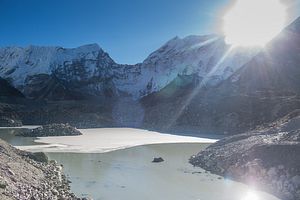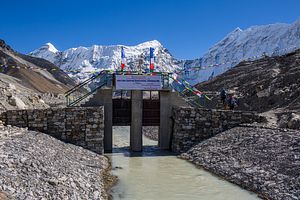Early on November 23, a group of eight Buddhist monks in maroon robes sat cross-legged on the banks of a glacial lake located at 5,010 meters above sea level. They offered Buddhist prayers as dignitaries from Kathmandu descended on a military helicopter. A group of Sherpa women in traditional dresses offered silken scarves to the delegates.
This was the culmination of months of painstaking work to lower the water level of one of the most dangerous glacial lakes in the Himalayas. In summer this year, Bharat Lal Shrestha, a lieutenant colonel at Nepal Army’s Engineering Department, led a group of 40 army soldiers and 100 high altitude workers, including Sherpas, to drain the waters of Imja Tsho, one of six most dangerous glacial lakes of Nepal, home to 1,466 such lakes.
Experts have warned that Imja Tsho, which lies just south of Everest, poses a danger to tens of thousands of people living downstream and threatens to damage the teahouses, settlements, and trekking trails that are key to attracting tourists. Until 1960, the lake, one of 21 lakes in the Nepali Himalayas at risk of bursting, was small in size, but since then, it has expanded rapidly: now it covers an area of 1.28 square kilometers and is 150 meters deep. Three major events of Glacial Lake Outburst Floods (GLOF) in the Everest region between the late 1970s and late 1990s, along with last year’s devastating earthquake, prompted Nepal’s government and United Nations Development Program (UNDP) to carry out the mammoth task of draining Imja Tsho.
The team drained almost 4 million cubic meters of water, lowering the lake’s water level by 3.4 meters. “This was very challenging because of high altitude. We had to be motivated to keep going in such harsh environment,” Shrestha told The Diplomat. His team faced a host of challenges, including transporting heavy equipment for the construction of an outlet and a 45 meter cement and concrete canal. “We worked in two shifts from seven in the morning to five in the evening. People needed a lot of rest and we constantly supplied hot water and coffee to the workers,” he said. The team members were served dry food, which was carried to the site using yak, a large, shaggy-haired animal domesticated in the Himalayas. “Whenever a worker suffered from altitude sickness, we arranged for a trip to lower altitude. We also had medical doctors, who regularly carried out check-ups,” Shrestha said.
This was not the first draining of a glacial lake in the Nepali Himalayas. In 2000, Nepal’s Department of Hydrology and Meteorology lowered Tsho Rolpa, a glacial lake in northeast Nepal’s Dolakha district, by three meters. The lowering of water in Imja Tsho averts the bursting of the lake and could help save the lives of the 87,782 people living downstream, according to the UNDP. If the Imja Tsho bursts, it would incur an estimated loss of $11 billion, according to a 2009 study by International Center for Integrated Mountain Development, a regional knowledge center based in Kathmandu. But for now, such risk has been significantly reduced.
Deepak Adhikari is a Kathmandu-based freelance journalist, who covers Nepal for international publications.
Nabin Baral is a Kathmandu-based freelance photojournalist specializing in social and environmental issues.














































